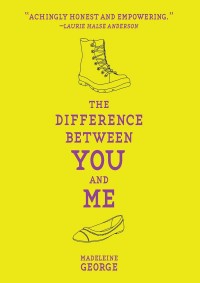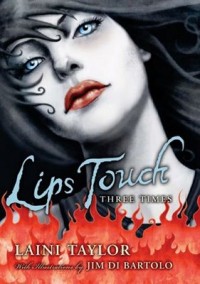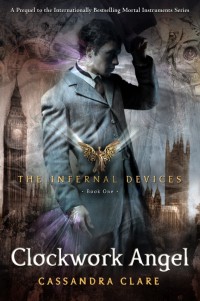Writing About Kissing
I took a week last week "off," and it was glorious. The only way I could convince myself to get back to work today was by deciding to finally write this blog post about kissing. Not real kissing, but fictional kissing. I've been thinking about fictional kissing for a while now because, let's face it: I'm a young adult author, and all of my books have fictional kissing in them. ((Also, there is a lot of fictional kissing in my next two books. Much more than in my first two, so that's another reason I've been thinking about fictional kissing so much.))
Then I read a book called The Difference Between You and Me by Madeleine George and I thought, damn, that is the best example of fictional kissing I've ever read in a YA novel. And because I'm a writer, I started to poke at what exactly made that fictional kissing scene so good. Why did it work so well? That made me pull out other YA novels that I remembered also contained excellent examples of fictional kissing, in order to dissect them from a writerly perspective. And I discovered that there is quite a variety of fictional kissing, from which we can learn some lessons. ((As always, writing "rules" are made to be broken. These aren't rules; they're observations, and there are always exceptions.))
[SPOILER WARNING: In in this post I discuss kissing scenes in The Difference Between You and Me by Madeleine George, "Goblin Fruit" by Laini Taylor, and Clockwork Angel by Cassandra Clare.]
It's So Bad It's Good
 Madeleine George's The Difference Between You and Me is about two girls, Jesse and Emily, who come from very different social circles and political beliefs, yet find time to make out together once a week in the library's bathroom. Emily narrates the chapters from her perspective, and it's in her very first chapter that we get to the kissing scene that made me sit up and take notice. It begins, however, by describing a very bad kiss, with her boyfriend, Michael:
Madeleine George's The Difference Between You and Me is about two girls, Jesse and Emily, who come from very different social circles and political beliefs, yet find time to make out together once a week in the library's bathroom. Emily narrates the chapters from her perspective, and it's in her very first chapter that we get to the kissing scene that made me sit up and take notice. It begins, however, by describing a very bad kiss, with her boyfriend, Michael:
"When me and Michael kiss, it's like I'm making out with a cut cantaloupe. He is the wettest, squishiest kisser on the planet. He's so cute from a distance, you know, he's such a good-looking guy, like a male model practically, but then when he goes to kiss me it's like all the muscles in his face go slack and his lips get all spongy and loose and he opens his loose face and sort of lays his spongy lips all over me and drools his melon-juice spit into my mouth. It's horrible. I don't mean to criticize him, I'm sure lots of other girls would think he was a totally amazing kisser, it's just … sometimes I have to pretend he's getting too powerful and intense and I push him off me, but really I'm pushing him off me because he's getting too disgusting."
— The Difference Between You and Me, pages 20-21
Things that I love about this kiss:
- Voice: Emily's voice is hilarious. There's such a wonderful combination of grossed-outness and bizarre pride in her voice. She thinks Michael is a horrible kisser, but she takes time to praise Michael for how attractive he is. This says so much about Emily, who continues to date Michael even while she's secretly making out with Jesse.
- Simile used very effectively: How perfect is the cantaloupe simile? I'd guess that most people reading this scene have eaten cantaloupe (or melon) before. That means the reader is right there, instantly, in Emily's memory. You know exactly how kissing Michael feels to her, and I bet you all just went, "Ewww!"
- Contrast: This kiss sets up the next kiss that Emily describes, which is far from disgusting to her.
The Kiss That Makes Your Knees Weak
A few lines later, Emily describes kissing Jesse:
"When Jesse Halberstam kisses me, she's really focused and really intense. She puts her hands on the sides of my face to hold me where she wants me, or she winds her fingers up in my hair and tugs it tight, and somehow, just by the way she touches me, she makes my mouth open, she makes my eyes close, she makes me breathe faster and faster until I feel dizzy and I think I might black out. Sometimes when she's kissing me, I swear to God, the edges of my body melt and I become sort of part of her. Sometimes when she kisses me I forget my own name."
— The Difference Between You and Me, page 21
Why does this kiss work?
- Feelings: The focus is on Emily's feelings. How the kiss makes her dizzy, how it makes her forget her own name.
- Contrast: This kiss has the benefit of being contrasted with the horrible one with Michael. Clearly, Jesse operates differently. Where Michael was sloppy, Jesse is focused and intense. Michael drools, but there is no drool here.
- Power: Emily's physical experience is definitely referenced, but rather than focusing on her mouth — which is where a lot of kissing descriptions tend to center — it focuses on Jesse's fingers tugging her hair and drawing a response out of Emily ("she makes my mouth open, she makes my eyes close"). This description brings up something that appears over and over in effective fictional kissing scenes: power. Not necessarily in a Fifty Shades of Gray way, but every time two people come together in a kiss, there is a physical and often emotional negotiation going on. Who is in control? Who is totally swooning? Are they both completely bonkers for each other? Or is one less bonkers than the other? This relationship negotiation occurs in every kiss and without it, the kiss can often feel flat.
The Deadly Kiss
 That power negotiation comes to bear most obviously in kisses that aren't meant to be good for the character involved. In Laini Taylor's beautifully written story "Goblin Fruit" from her collection Lips Touch, Kizzy encounters a gorgeous man who, she discovers, is not exactly looking out for her best interests. He is a goblin, or perhaps a fairy — the kind who puts on glamours and seduces young girls. The wolf in sheep's clothing. But what does Kizzy (and isn't her name so perfect?) do when she discovers this?
That power negotiation comes to bear most obviously in kisses that aren't meant to be good for the character involved. In Laini Taylor's beautifully written story "Goblin Fruit" from her collection Lips Touch, Kizzy encounters a gorgeous man who, she discovers, is not exactly looking out for her best interests. He is a goblin, or perhaps a fairy — the kind who puts on glamours and seduces young girls. The wolf in sheep's clothing. But what does Kizzy (and isn't her name so perfect?) do when she discovers this?
"Kizzy knew, but she willfully unknew it, and the plangent voices of the dead were lost to the drum of her hot blood and the tingle of her ready lips. She wanted to taste and be tasted.
She didn't reach for the knife. Heavily and hypnotically, with her soul flattening itself back like the ears of a hissing cat, Kizzy leaned in and drank of Jack Husk's full, moist mouth, and his red, red lips were hungry against hers, drinking her in return. Their eyes closed. Fingers clutched at collars and hair, at the picnic blanket, at the grass. And as they sank down, pinning their shadows beneath them, the horizon tipped on its side, and slowly, thickly, hour by hour, the day spilled out and ebbed away.
It was Kizzy's first kiss, and maybe it was her last, and it was delicious."
— "Goblin Fruit," page 54
Here we have a truly deadly kiss, and several things are going on:
- Character revelations: Kizzy knows that Jack Husk isn't good for her, but her desire for him overrides her desire for safety. This shows that Kizzy is complicit in her own demise — which tells us a lot about her.
- Describing the mouth is almost always disturbing: There is something overwhelmingly lush and simultaneously off about this kiss, and I think that comes from the description of Jack Husk's "full, moist mouth, and his red, red lips," which Kizzy drinks from. What does that sound like? A bit vampiric, no? If there's one thing I strongly believe to be true about fictional kissing scenes, it's that physical descriptions of lips and the mouth in action should largely be avoided … unless you want to make the reader feel a little squicked out. And that's exactly what Taylor has done in this scene.
- Anticipation: This kiss comes at the very end of a 41-page story, which means there were 40 pages of buildup before it. Throughout the story we get to know Kizzy and her urgent desire to be kissed, but she isn't kissed until the very last page. "Goblin Fruit" is about the power of wanting something deadly — in Kizzy's case, this kiss — and every word that comes before the last line is used to aim us toward that moment when Kizzy kisses Jack Husk. Creating this sense of anticipation in the reader is one of the best ways to make a fictional kiss effective.
The Thrill of Anticipation
 The Queen of Making You Wait for the Kiss is, in my mind, Cassandra Clare. In Clockwork Angel, Tessa Gray meets Will Herondale on page 35, but it isn't until page 290 that It Happens:
The Queen of Making You Wait for the Kiss is, in my mind, Cassandra Clare. In Clockwork Angel, Tessa Gray meets Will Herondale on page 35, but it isn't until page 290 that It Happens:
"Her whole body ached; she ached as if there were a terrible hollow emptiness inside her. She was more conscious of Will than she had ever been of anything or anyone else in her life, of the faint shine of blue beneath his half-closed lids, of the shadow of light stubble across his jaw where he hadn't shaved, of faint white scars that dotted the skin of his shoulders and throat—and more than anything else of his mouth, the crescent shape of it, the slight dent in the center of his bottom lip. When he leaned toward her and brushed his lips across hers, she reached for him as if she would otherwise drown.
For a moment their mouths pressed hotly together, Will's free hand tangling in her hair. Tessa gasped when his arms went around her, her skirts snagging on the floor as he pulled her hard against him. She put her hands lightly around his neck; his skin was burning hot to the touch. Through the thin wet material of his shirt, she could feel the muscles of his shoulders, hard and smooth. …"
— Clockwork Angel, pages 290-291
Some things to note:
- Escalating tensions: From the very first time that Tessa sees Will, you know she finds him attractive ("He had the most beautiful face she had ever seen." — page 36). What happens between page 35 and page 290 is a series of escalations that (hopefully) makes the reader become invested in bringing the two of them together.
- Kissing is about more than the mouth: Will's mouth is described, but only before the kiss. After the kiss begins, the mouth is not described. Instead, Clare describes Tessa's encounter with Will as a whole person—hands, arms, body. Kissing uses the whole body, not just the mouth. (At least, good kisses!)
- Physical specificity: There's nothing I hate more in a kissing scene than vagueness; that sense of pulling a gauzy veil over everything. Kissing is usually not a vague experience — and if it is, there is a reason for that vagueness. ((Drugs? Bad memory? The main character didn't want to be in the moment?)) Therefore, kissing scenes shouldn't be vague, either. But you do want to avoid making a character's physical actions sound like a medical textbook. A good trick for doing that is to choose part of the body to describe (preferably not the mouth) and describe it from the perspective of one character. In this case, you have Tessa's experience of touching Will's shoulders through the "thin wet material of his shirt." Specific! But not clinical.
In Conclusion
Whether a fictional kissing scene is effective can be a matter of debate. Some of it does certainly depend on the reader: whether they're invested in the couple, whether they like romance, whether they like the writer's style. But there are some things that I think every effective kissing scene has in common:
- They reveal something interesting about the characters involved.
- They acknowledge that a power dynamic exists between the two kissers.
- They're specific without being clinical.
What do you think makes a good fictional kiss?